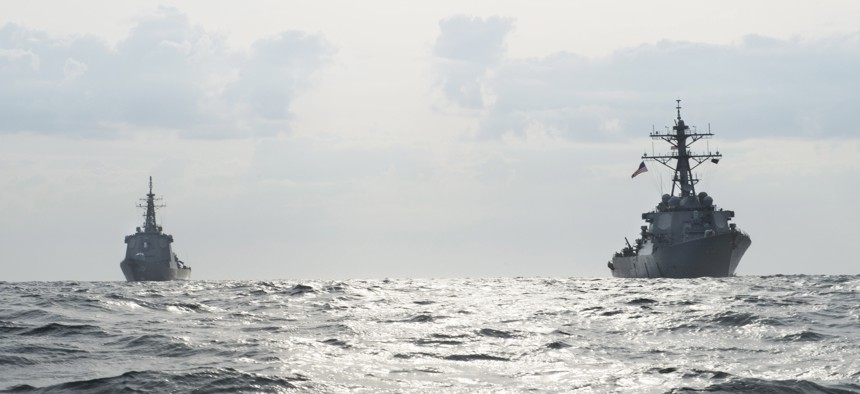
The Arleigh Burke-class guided-missile destroyer USS Fitzgerald (DDG 62) conducts a bilateral training exercise with the Japanese Maritime Self-Defense Force Kongou class guided-missile destroyer JS Choukai (DDG 176), April 25, 2017. Photo by Mass Communication Specialist 2nd Class William McCann
The US, Japan, and South Korea Need to Get on the Same Page
As tensions with North Korea heat up, mutual mistrust and diverging priorities make it harder to choose a path forward.
Even as the United States and her Pacific allies coalesce around a shared belief that new measures must be taken with regard to North Korea, mutual mistrust and diverging priorities make it harder to choose a path forward.
Last August, well before the current sense of crisis, these gaps in coordination and trust were highlighted at the annual US-ROK-Japan Trilateral Strategic Dialogue. Hosted by Pacific Forum CSIS with the Asan Institute for Policy Studies, the event brings together experts, officials, military officials, and observers from the three countries to simulate a North Korea crisis. Its goal is to find areas of convergence in strategic and tactical goals, but more importantly, to find divergence among the partners. Here are some of the issues that remain unresolved, even as last year’s simulation draws closer to reality.
Nuclear attack aside, Seoul’s 10 million residents live within minutes of North Korea’s heavy artillery, short-range ballistic missiles, and chemical weapons. Within this population is about 60,000 Japanese nationals, whose evacuation during a crisis would seem like a standard operating procedure. However, even this planning has become a thorny issue in ROK-Japan strategic planning. Given the sensitivities in South Korea over Japan’s former colonization of the Peninsula, the thought of Japan’s Self-Defense Forces on Korean soil, even to help with a noncombatant evacuation operation (NEO), stokes anger among South Koreans. This became apparent during the simulation, and again just a few weeks ago, when Japan’s National Security Council and Defense Minister Tomomi Inada both talked about the possibility of deploying Japanese troops to protect and evacuate its Korea-dwelling citizens in a crisis. Seoul was quick to express displeasure, with one official suggesting that Japan refrain from remarks that “can have a negative influence on the peace and security of the Peninsula.” South Korean social media was less forgiving, with some netizens suggesting that Japan is waiting for war, as it will “be an excuse to make its Self-Defense Forces stronger.” The ROK-Japan inability to cooperate on something as soft as a NEO casts doubt on their ability to respond to a crisis.
When it comes to China, all three countries agree that cooperation and coordination with Beijing during a crisis will be key, but they diverge tactically. South Korea, whose need for a positive relationship with Beijing is a geopolitical fact, prefers full transparency and clarity in its messaging to China; South Korea’s need to work with China in any post-Kim Jong-un environment is also a driving factor. Conversely, the U.S. favors a more opaque stance in its China messaging so as not to give Beijing an opportunity to thwart any war aims. Today’s political setting threatens to exacerbate this issue. President Trump, who has frequently dismissed tactical transparency, shows no signs that he would share any military strategy with China during a North Korea crisis. Moon Jae-in, South Korea’s progressive presidential front-runner, may seek to reset relations with North Korea and China. Moon has expressed interested in reopening the Kaesong Industrial complex and perhaps even attempting a summit with Kim Jong-un. Whether he would share tactical plans with China during a crisis is unknown, but how the U.S. and ROK message with China is likely to be an area of contention.
Territorial disputes may also undermine a US-ROK-Japan response. The Japanese worry that China might use a crisis to make gains in the South or East China Sea, and wonder whether they should take preemptive steps to defend the disputed Senkaku/Diaoyu Islands. This is alarming. Such a move would divert valuable Japanese naval and air assets from the mission on the Peninsula; it would also threaten a separate conflict with China. Cooperation between Japan and China on territorial disputes would help prevent such actions, but there remains to be any progress in this area. Conversely, Japan’s Air Self-Defense Force (JASDF) fighter jets were scrambled 1,168 times in the year ending March 31, the largest annual total since 1958. Almost three-quarters of the scrambles were caused by Chinese aircraft.
The fog of war during a North Korea crisis could breed unlimited scenarios, including the use of nuclear weapons and chemical warfare against millions. Coordination on the knowns is a concrete way that Washington, Seoul, and Tokyo can begin working toward a broader North Korea strategy. Details on military tactics, NEOs, and the use of limited military resources have the potential to undermine the US-ROK-Japan response, but can also serve as stepping stones to developing teamwork and synergy. The road north of the 38th parallel is full of unknowns, but the journey must begin well before it.




